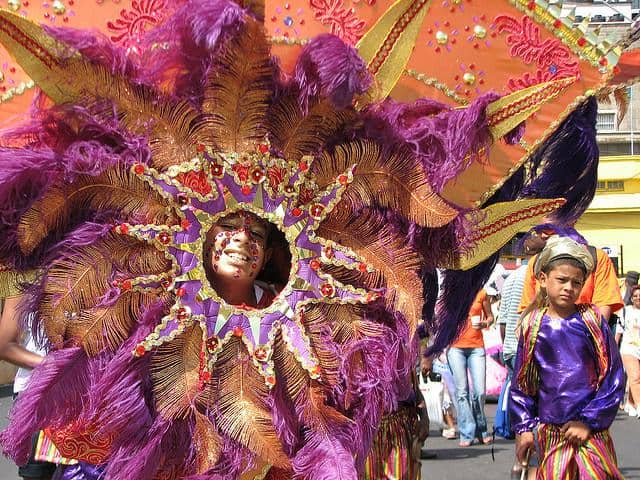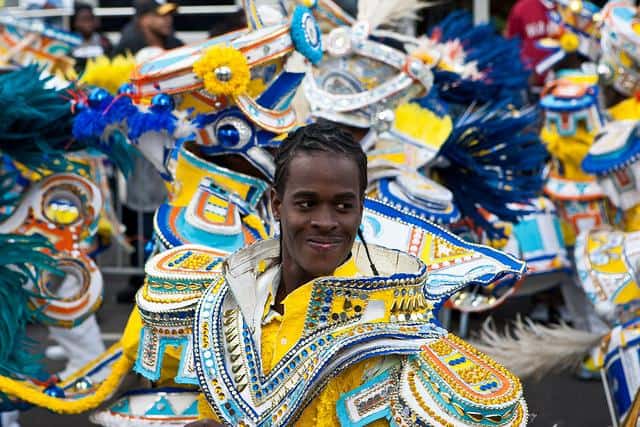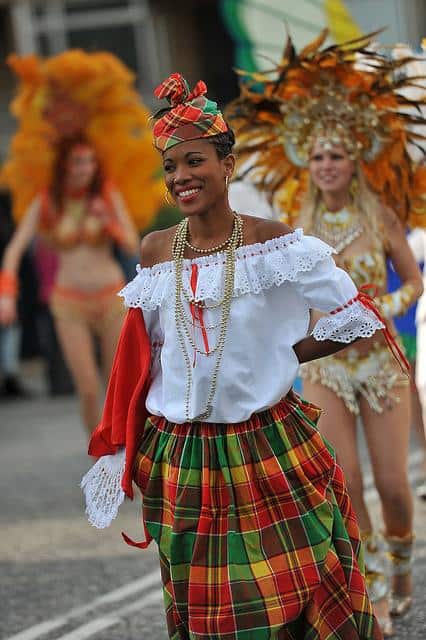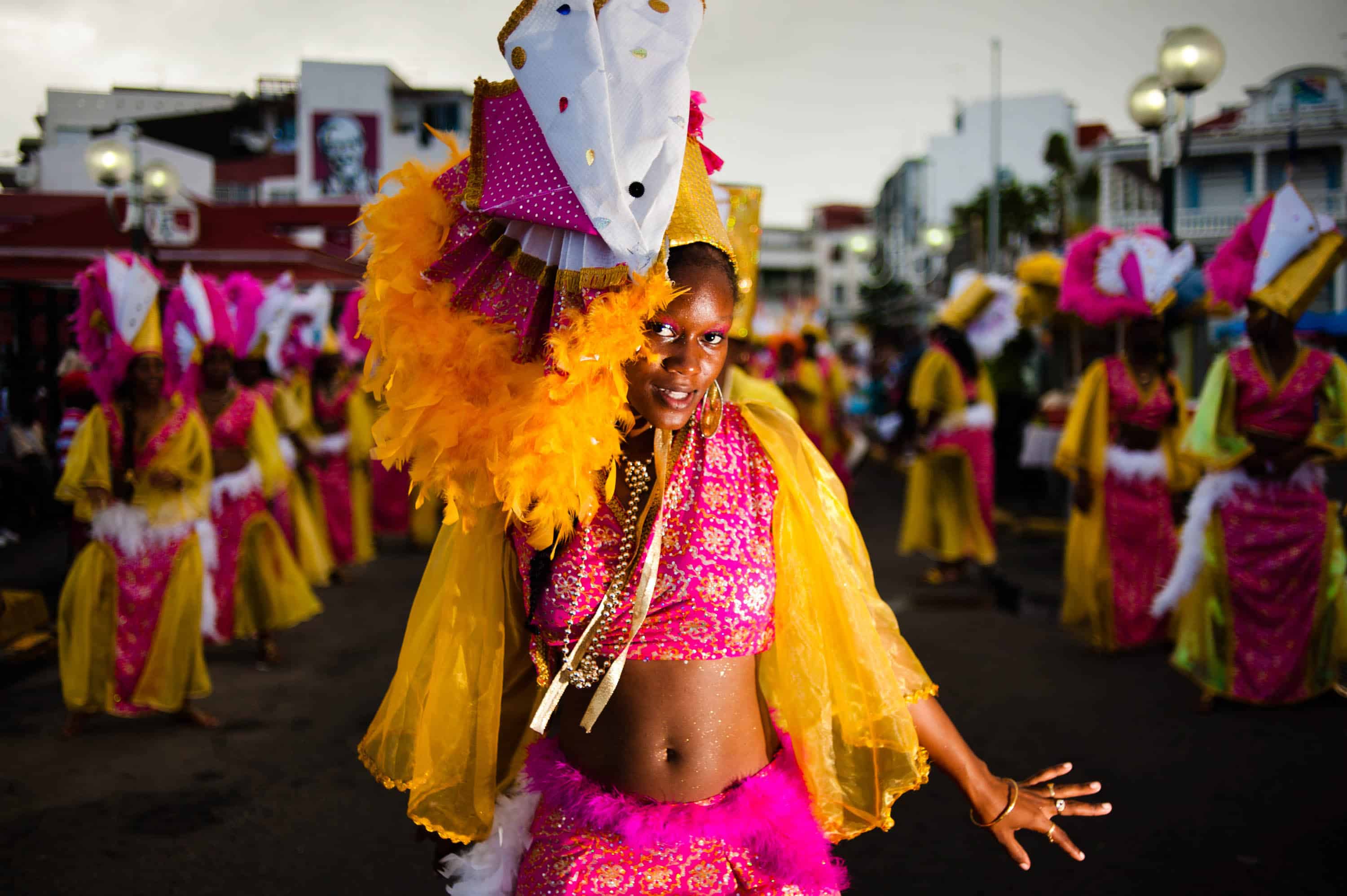
1. Carnival
Trinidad And Tobago
The carnival celebration in Trinidad and Tobago is easily the most famous celebration in the Caribbean. Though native people from Trinidad and Tobago are mostly Christian converts today, when this celebration originated in the 18th century their carnival was celebrated by slaves in part to mock the pre-Lenten celebration of the French plantation and slave owners.
After the abolishment of slavery in 1838, the festival remained, taking up strong cultural roots in the community, most likely because it was so much fun. Now carnival has become an energetic celebration of life that starts every year at 4am with J'Ouvert. This pre-dawn celebration is marked by the booming sound of Soca music in the streets, aimed to celebrate the darker side of the island’s folklore. When the Soca music sounds, all sorts of revellers emerge in the streets painted in mud, paints, oils and occasionally chocolate, dressed up as devils, imps and monsters.
After the sun rises and Monday dawns, the demons of J'Ouvert dissipate and all forms of drinking, dancing and general merriment happen in the streets. This party is carried into Tuesday when groups are ready to strut in front of television cameras for the annual costume contest.
2. Vincy Mas
Saint Vincent And The Grenadines
Vincy Mas, the massive celebration in St Vincent and the Grenadines, is similar in origin to that of the carnival in Trinidad and Tobago. The celebration was brought to them by the French, then continued by the slaves and native people after Great Britain took over. When slavery was abolished this version of carnival took to the streets in a massive street party.
While Vincy Mas used to take part in February in order to party down before Lent, the date was moved in 1976. It was decided by the Carnival Development Committee (CDC) that the festival would be a better in the summer months, so it was moved to the June/July season. This summer carnival still starts with the demons of J'Ouvert and continues to celebrate the talent of local Panists, Calypsonians, and Masqueraders in a variety of competitions in between the merriment.
3. Junkanoo
The Bahamas
 Creativecommons.org/Cathy T
Creativecommons.org/Cathy T
Traditionally taking place on December 26th, the carnival-like celebration of Junkanoo originated as a special holiday that was given to slaves in the 16th century. After emancipation, the celebration stuck, transforming into a more formal parade of costumes, music and general celebration.
While no one in the Bahamas is quite sure what 'Junkanoo' actually means, it is thought to originate from the French word 'L'inconnu', meaning 'the unknown'. Today, the various cities throughout the Bahamas celebrate it on the original day, at New Year and during the summer months. However, the largest celebration is held in the capital of Nassau with grand dancing troupes busting out their grand routines, musicians playing hypnotic rhythms on goatskin drums and imaginative costumes everywhere the eye can see.
4. Crop Over
Barbados
Crop Over is a carnival-like summer festival that has its roots in the rich agricultural history of Barbados. As the most popular and colourful of festivals in Barbados, Crop Over has been celebrated since the 1780s. Since then at the end of sugar season, crowds flood the streets to enjoy live music, dancing, costume parades and enjoy food and drink in mass. Crop Over is traditionally kicked off with the ceremonial giving of the last canes, in which the last harvested sugar canes are turned over, and then the King and Queen of the Festival are named. The King and Queen are the most productive sugar cane cutters of the season, which has served as motivation for the workers since the very first Crop Over. While most of the competitions and parades are exclusive to locals, the spectacle draws thousands of visitors from all over the world.
5. Independence Festival
Jamaica
Since Jamaica gained its independence in 1962 from the United Kingdom, the country has held a festival every year on August 6th. It has become so popular over the years that the Jamaica Cultural Development Commission that now plans the event has stretched the merriment over the span of several days.
While not the pre-Lenten carnival of other Caribbean countries, the celebration holds many similarities. Like carnival in many countries, this festival celebrates the joy of being free. The Independence Day festival includes the crowning of the Queen, costume contests, competitions between local gospel singers and mento bands (a form of Jamaican folk music) and exhibitions by local craftsmen.
The Popular Song Competition is a big highlight. The song that is voted the most popular is awarded one million dollars and a car. Previous winners include such fame as The Maytals, Desmond Dekker, and Freddie McKay.
6. Carnival
Martinique
 Creativecommons.org/Aalborg Carnival - Photographs
Creativecommons.org/Aalborg Carnival - Photographs
Like many of the other carnivals in the Caribbean, the carnival in Martinique takes place over the course of the days leading up to Lent. Prior to the event, the island practically grinds to a halt as the locals prepare for the festivities. Festivities officially kick off on Epiphany Sunday with the crowning of the King and Queen of Carnival. The festivities of the following days each have a theme. Fat Monday is all about comical wedding ceremonies, Fat Tuesday is red devils and Ash Wednesday is she-devils and black and white dress.
The biggest event is saved for Ash Wednesday. This is where the giant carnival effigy, the Vaval King and his alter ego Bwa-Bwa are dragged through the streets and then burned. While Lent is the end for most carnivals, the general mischief and merriment of carnival on Martinique is revived three weeks later for a 24-hour reprisal of the festivities called Mi-Careme. While there is no Vaval effigy, there are costumes, parades, endless scores of marching bands and much rum.
7. Spicemas
Grenada
While the Spicemas celebration in Grenada evokes memories of gingerbread, nutmeg,and all things Christmasy, it is actually an August celebration. Spicemas is Grenada's carnival; a celebration of all the cultures that melted in the area over the years. With all these different cultures, Spicemas is brimming with pageantry.
The festival kicks off much like any other carnival celebration, early in the morning with the island’s answer to J'Ouvert – Jab Jab. In this pre-dawn parade, revellers are painted black from head to toe with fierce helmets sporting horns on their heads. These revellers stomp through town, keeping true to the old tradition of trying to scare carnival-goers.
Alternatively, there are those in the infamous Shortknee costumes. This old Grenada tradition has carnival-goers in expressive masks and costumes carrying around mirrors to repel their enemies, the Jab Jabbers. For those not scared off by the Jab Jab, they can look forward to parades, surprise performance by calypso bands and beauty contests.
8. Haitian Defile Kanaval
Haiti
While the devastating 2010 earthquake has diminished what was once the largest of the Caribbean's carnival celebrations, Haitians won't let tragedy or Mother Nature's wrath stop their merriment forever.
This celebration keeps true with the traditional carnival celebration and takes place over the few days before Lent. It has been a staple in Port-au-Prince since the 1800, when it is earned the name "defile" Kanaval by Haitian Protestants who thought the celebration condoned sinful action. The name has stuck over the years.
While there is nothing particularly outrageous about the celebration by today's standards, it is still no less fun. Parade floats blasting local music slowly make their way through the crowded streets, bands play well into the night, comedy plays take to the stage and local men prove their metal by engaging in Gagann – ritual fights in which they attempt to shove opponents to the ground with blows to the chest. Defile Kanaval has all the elements that make for a great celebration, which is why it attracts hordes of tourists each year.
9. Batabano
Cayman Islands
Batabano is the Cayman Islands answer to carnival, but only starting in 1983, it is by far the youngest in comparison to its neighbours.
Unlike other carnival celebrations, Batabano leaves the traditional Lent connections of the celebration in the dust. Instead the locals chose to celebrate their African history as well as the other vibrant cultural mixes that make up its current population. The festival takes place in May and the name references the tracks that are made by turtles as they travel from their beach nests to the sea. Finding the turtle's tracks in the sand are validation that these shy creatures continue to exist, making for good reason to celebrate. The cultural celebration is a kaleidoscope of music, dancing and pageantry that mirrors the island’s many cultures. Since Batabano is so young, this electrifying celebration grows more elaborate each year that unites visitors and local people that wish to celebrate during the month of May.
Have you attended any of these festivals?
Let us know - comment below or tweet us
Related content on Canadian Traveller:


